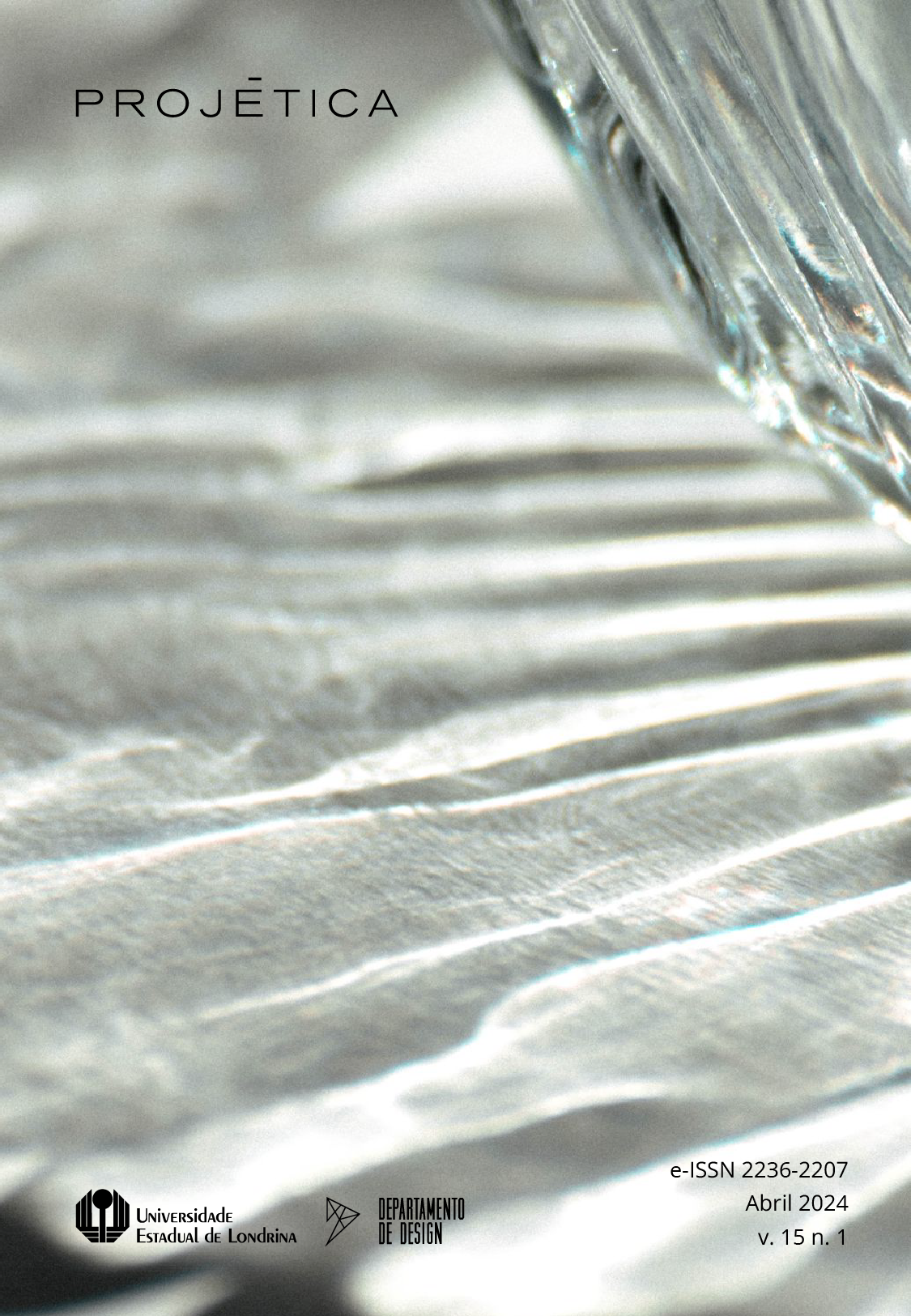Retail Design para concepção de pontos de venda sensíveis ao humor
Oportunidades para a regulação do humor em experiências gastronômicas
DOI:
https://doi.org/10.5433/2236-2207.2024.v15.n1.47398Palabras clave:
Retail design, Humor, Design para humor, ponto de vendaResumen
A evolução do consumo possibilitou o surgimento do retail design tornando as experiências no ponto de venda (PDV), um fator central para compreensão do comportamento do cliente. Por meio de avaliações de humor, entrevistas com usuários, workshop com projetistas e avaliações com psicólogos, o artigo propõe a criação de um conjunto de 41 estratégias de retail design para se projetar PDV's gastronômicos sensíveis ao humor do usuário. Ademais das estratégias, o estudo traz a importância do papel do design e do humor nas experiências do varejo gastronômico.
Descargas
Citas
ADDIS, Michela; HOLBROOK, Morris B. On the conceptual link between mass customisation and experiential consumption: an explosion of subjectivity. Journal of Consumer Behaviour, New York, v. 1, n. 1, p. 50-66, 2001. DOI: https://doi.org/10.1002/cb.53
ARNOLD, Magda B. Emotion and personality. New York, NY: Columbia University Press, 1960.
BOWER, Gordon H. Mood and memory. American Psychologist, Washington, US, v. 36, n. 2, p. 129, 1981. DOI: https://doi.org/10.1037//0003-066X.36.2.129
CARÙ, Antonella; COVA, Bernard (ed.). Consuming experience. Oxfordshire: Routledge, 2007.
CHRISTIAANS, Henri H. C. M.; ALMENDRA, Rita A. Retail design: a new discipline. In: DS 70: DESIGN 2012: International Design Conference, 12th, 2012, Dubrovnik, Croatia. Proceedings […]. Dubrovnik: The Design Society, 2012. p. 1893-1902.
CSIKSZENTMIHALYI, Mihaly. Flow and the foundations of positive psychology. Dordrecht: Springer, 2014. v. 10. DOI: https://doi.org/10.1007/978-94-017-9088-8
DEMIR, Erdem; DESMET, Pieter; HEKKERT, Paul. Appraisal patterns of emotions in human-product interaction. International Journal of Design, Taiwan, v. 3, n. 2, p. 41-51, 2009.
DESMET, Pieter. A multilayered model of product emotions. The Design Journal, Birmingham, v. 6, n. 2, p. 4-13, 2003. DOI: https://doi.org/10.2752/146069203789355480
DESMET, Pieter. Design for mood: twenty activity-based opportunities to design for mood regulation. International Journal of Design, Taiwan, v. 9, n. 2, p. 1-19, 2015.
DESMET, Pieter. Designing emotions. The Design Journal, Birmingham, v. 6, n. 2, p. 60-62, 2002. DOI: https://doi.org/10.2752/146069203789355444
DESMET, Pieter; POHLMEYER, Anna. E. Positive design: an introduction to design for subjective well-being. International Journal of Design, Taiwan, v. 7, n. 3, p. 5-19, 2013.
FIORE, Ann Marie; KIM, Jihyun. An integrative framework capturing experiential and utilitarian shopping experience. International Journal of Retail & Distribution Management, Leeds, UK, v. 35, n. 6, p. 421-442, 2007. DOI: https://doi.org/10.1108/09590550710750313
FRIJDA, Nico H. The emotions. Cambridge: Cambridge University Press, 1986.
GLUHAK, Alexander; PRESSER, Mirko; ZHU, Lin; ESFANDIYARI, Stefan. Towards mood based mobile services and applications. In: KORTUEM, Gerd; FINNEY, Joe; LEA, Rodger; SUNDRAMOORTHY, Vasughi (ed.). Smart sensing and context. Berlin: Springer-Verlag, 2007. p. 159-174. (Lecture Notes in Computer Science, v. 4793). DOI: https://doi.org/10.1007/978-3-540-75696-5_10
HANSEN, Kai Victor; JENSEN, Øystein; GUSTAFSSON, Ingaâ€Britt. The meal experiences of á la carte restaurant customers. Scandinavian Journal of Hospitality and Tourism, Stavanger, Norway, v. 5, n. 2, p. 135-151, 2005. DOI: https://doi.org/10.1080/15022250510014417
KUTLU, Rana; MANAV, Banu; KILANC, Ruken O. Retail design: color-light influence on brand identity-image perception. World Applied Sciences Journal (WASJ), Pakistan, v. 23, n. 5, p. 598-606, Jan. 2013. DOI:10.5829/idosi.wasj.2013.23.05.219
LANE, Andrew M.; TERRY, Peter C. The nature of mood: development of a conceptual model with a focus on depression. Journal of Applied Sport Psychology, Philadelphia, PA, v. 12, n. 1, p. 16-33, 2000. DOI: https://doi.org/10.1080/10413200008404211
LAZARUS, Richard S. Emotion and adaptation. New York: Oxford University Press, 1991. DOI: https://doi.org/10.1093/oso/9780195069945.001.0001
MORAES, Roque. AnaÌlise de conteuÌdo. Revista Educação, Porto Alegre, v. 22, n. 37, p. 7-32, 1999.
MOURA, Thais Lacava de. Formatos de varejo de alimentos: um estudo sobre as preferências do consumidor. 2005. Dissertação (Mestrado em Engenharia de Produção) - Universidade Federal de São Carlos, São Carlos, SP, 2005.
NORMAN, Donald. Emotional design: why we love (or hate) everyday things. New York: Basic Books, 2004.
NOWLIS, Vincent; NOWLIS, Helen H. The description and analysis of mood. Annals of the New York Academy of Sciences, New York, NY, v. 65, n. 4, p. 345-355, 1956. DOI: https://doi.org/10.1111/j.1749-6632.1956.tb49644.x
PETERMANS, Ann. Retail Design in the experience economy: conceptualising and 'measuring' customer experiences in retail environments. 2012. Thesis (PhD in Architecture) - Hasselt University, Hasselt, Belgium, 2012.
PETERMANS, Ann; KENT, Anthony (ed.). Retail design: theoretical perspectives. New York: Taylor & Francis, 2016. DOI: https://doi.org/10.4324/9781315605920
PINE, Joseph.; GILMORE, James. The experience economy - work is theatre and every business a stage. Boston: Harvard Business School Press, 1999.
PULLMAN, Madeleine E.; GROSS, Michael A. Ability of experience design elements to elicit emotions and loyalty behaviours. Decision Sciences, Atlanta, Ga, v. 35, n. 3, p. 551-578, 2004. DOI: https://doi.org/10.1111/j.0011-7315.2004.02611.x
QUARTIER, Katelijn. Retail Design: lightning as a Design tool for the retail environment. Hasselt, Belgium: Hasselt University, 2011. PDF available - https://www.researchgate.net/publication/304015461
QUARTIER, Katelijn. Retail design: what's in the name? In: PETERMANS, Ann; KENT, Anthony (ed.). Retail design: theoretical perspectives. New York: Taylor & Francis, 2016. p. 31-47.
SALAZAR, Viviane Santos. Influência hedônicas na satisfação do consumidor de restaurantes. 2006. Dissertação (Mestrado em Administração) - Universidade Federal de Pernambuco, Recife, 2006.
SELIGMAN, Martin E. P.; CSIKSZENTMIHALYI, Mihaly. Positive psychology: an introduction. American Psychologist, Washington, US, v. 55, n. 1, p. 5-14, 2000. DOI: https://doi.org/10.1037//0003-066X.55.1.5
SPIES, Kordelia; HESSE, Friedrich; LOESCH, Kerstin. Store atmosphere, mood and purchasing behavior. International Journal of Research in Marketing, New Delhi, India, v. 14, n. 1, p. 1 - 17, 1997. DOI: https://doi.org/10.1016/S0167-8116(96)00015-8
SPILLERS, Frank. Getting in the Mood: the role of mood in product design and interaction. In: INTERNATIONAL CONFERENCE ON DESIGN AND EMOTION, 7th, 2010, Chicago, ILL. Proceedings [...]. Chicago: Illinois Institute of Technology, 2010. p. 1-9. [PDF] Getting in the Mood
XUE, Haian; DESMET, Pieter M. A.; FOKKINGA, Steven F. Mood granularity for design: Introducing a holistic typology of 20 mood states. International Journal of Design, Taiwan, v. 14, n. 1, p. 1-18, 2020.
Descargas
Publicado
Cómo citar
Número
Sección
Licencia
Derechos de autor 2024 Vitória Borges da Fonseca Cumerlato, Filipe Campelo Xavier da Costa

Esta obra está bajo una licencia internacional Creative Commons Atribución 4.0.
Projética está licenciada sob a Creative Commons Attribution CC-BY 4.0 International. Os autores detém os direitos autorais e concedem à revista o direito de exclusividade de primeira publicação.
Os autores dos trabalhos aprovados autorizam Projética a, após a publicação, ceder seu conteúdo para reprodução em indexadores de conteúdo, bibliotecas virtuais e similares.
Os autores assumem que os textos submetidos à publicação são de sua criação original, responsabilizando-se inteiramente por seu conteúdo em caso de eventual impugnação por parte de terceiros. As opiniões emitidas pelos autores dos artigos são de sua exclusiva responsabilidade.
A revista se reserva o direito de efetuar, nos originais, alterações de ordem normativa, ortográfica e gramatical, com vistas a manter o padrão culto da língua e a credibilidade do veículo. Respeitará, no entanto, o estilo de escrever dos autores. Alterações, correções ou sugestões de ordem conceitual serão encaminhadas aos autores, quando necessário. Nesses casos, os artigos, depois de adequados, deverão ser submetidos a nova apreciação. As provas finais não serão encaminhadas aos autores.












